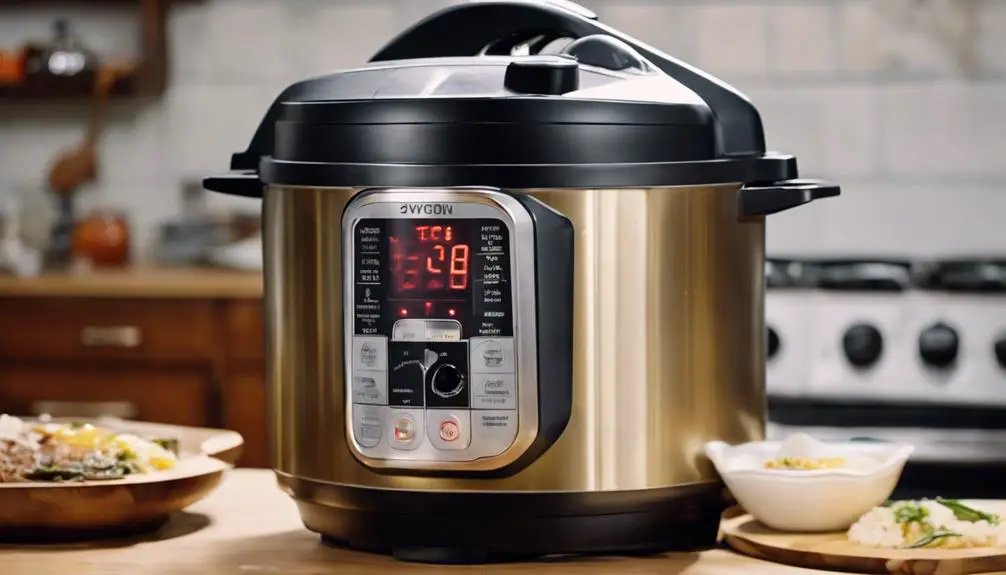When pondering the performance of a pressure cooker in evenly cooking your favorite fare, the query arises – does it truly achieve uniformity in cooking?
While pressure cookers are lauded for their efficiency, the matter of evenness in cooking remains a topic of intrigue.
The interplay of pressure, heat, and timing in this culinary contraption may hold the key to unlocking the secrets of consistent cooking.
Join us as we explore the nuances of pressure cooking and unravel the mystery behind its ability to cook food evenly from edge to core.
Key Takeaways
- Pressure cooking ensures even cooking by maintaining high pressure and consistent heat distribution.
- Proper layering and ingredient distribution are crucial for uniform results in a pressure cooker.
- Understanding pressure release techniques and heat spreading aids in cooking food evenly.
- Rapid steam circulation and efficient heat spreading contribute to consistent cooking results in pressure cookers.
Science Behind Pressure Cooking
Utilizing steam to elevate internal temperature and pressure, pressure cooking ensures even cooking by breaking down tough fibers in meat and creating a sealed, controlled environment with consistent heat distribution.
The high pressure within a pressure cooker plays a crucial role in transforming tough cuts of meat into succulent, tender bites by accelerating the breakdown of collagen. This process results in uniformly cooked meat that retains its moisture and flavor.
The controlled environment maintained by the pressure cooker prevents fluctuations in temperature, ensuring that every part of the food is subjected to the same level of heat. Furthermore, the rapid steam circulation facilitates the transfer of heat throughout the ingredients, promoting even cooking from the inside out.
Cooking Time Reduction Effectiveness
Given the significant reduction in cooking times of up to 70% compared to traditional methods, the cooking time reduction effectiveness of pressure cookers is a key advantage that stems from their high-pressure cooking environment.
When using a pressure cooker, the high temperature and pressurized steam allow for faster and more even cooking of various ingredients. This high-pressure environment ensures that heat is distributed uniformly throughout the food, resulting in dishes that are evenly cooked.
The faster cooking process not only saves you time but also helps in retaining the nutrients and flavors of the ingredients. Pressure cookers are particularly efficient in tenderizing tough cuts of meat, making them soft and juicy in a fraction of the time it would take using conventional cooking methods.
To achieve the best results and ensure even cooking, it's essential to layer ingredients properly and ensure there's enough liquid for steam formation within the pressure cooker. By utilizing a pressure cooker, you can enjoy evenly cooked meals without compromising on taste or quality.
Ingredient Consistency Examination
When examining ingredient consistency in a pressure cooker, focus on analyzing how evenly ingredients are distributed throughout the cooking process.
Evaluate the cooking time required for different ingredients to reach optimal tenderness levels, ensuring uniform results.
Assess the texture of various components post-cooking to determine if the pressure cooker achieved consistent outcomes.
Ingredient Distribution Analysis
Properly distributing ingredients in a pressure cooker is essential for ensuring consistent and even cooking results.
When it comes to ingredient distribution analysis, consider the following key points:
- Stacking Ingredients: Arranging ingredients like chicken pieces can aid in uniform cooking by facilitating efficient heat distribution.
- Layering Strategy: Strategically layering tougher and tender meat pieces can help achieve consistency in cooking.
- Even Spread: Ensuring all ingredients are evenly spread in the pressure cooker contributes to a balanced cooking process.
- Adequate Liquid: Having sufficient liquid and proper placement of ingredients are crucial for consistent cooking results.
- Balanced Cooking: Proper ingredient distribution is vital for maximizing the benefits of pressure cooking and achieving even, consistent outcomes.
Cooking Time Evaluation
To ensure consistent and even cooking results, evaluating cooking times in a pressure cooker is crucial for examining ingredient consistency. Pressure cookers, including electric models, work by creating high pressure that leads to uniform cooking times for various ingredients. The even distribution of heat and pressure within the cooker ensures that ingredients such as meat, vegetables, and grains cook uniformly.
Properly layering and arranging ingredients in the pressure cooker further contribute to achieving consistent cooking results. By monitoring cooking times based on the specific type and quantity of ingredients used, you can ensure that your dishes are cooked evenly throughout. This attention to detail in cooking time evaluation is key to achieving reliable and uniform results when using a pressure cooker.
Texture Assessment
For a thorough assessment of texture in a pressure cooker, focus on examining ingredient consistency to ensure even cooking results. When evaluating texture, consider the following:
- Ingredient Consistency: Assess how well different ingredients cook uniformly in the stainless steel container.
- Pressure Inside: Check how the pressure inside affects the cooking process and ingredient consistency.
- Even Cooking: Ensure that all ingredients, especially meat pieces, cook evenly for a consistent texture.
- Tender vs. Tough: Properly layer tougher and tender meat pieces for uniform cooking and desired tenderness.
- Stacking Technique: Experiment with stacking chicken or meat pieces to achieve even cooking throughout the dish.
Factors Influencing Cooking Uniformity
Stacking chicken in a pressure cooker can significantly influence the evenness of cooking by facilitating heat distribution throughout the meat. Proper layering of tougher and tender meat pieces can further enhance cooking uniformity.
It's essential to consider that the base of the pressure cooker tends to get hotter than the rest, affecting the tenderness levels differently in various meat pieces. Cooking times play a crucial role in the evenness of cooking, as they vary depending on the type of meat and the size of the pieces being cooked.
Moreover, ensuring there's sufficient liquid in the pressure cooker and following timing guidelines are vital factors in achieving consistent and even cooking results. By paying attention to these factors, you can optimize the cooking process and ensure that your food is cooked uniformly, providing a delightful dining experience for those you serve.
Pressure Cooker Design Impact
The design of a pressure cooker significantly impacts the tenderness levels of different meat pieces during the cooking process. Understanding how pressure cooker design influences cooking outcomes is crucial for achieving optimal results.
Here are some key points to consider:
- Stacking chicken in the pressure cooker can help achieve more even cooking results.
- Proper layering of tougher and tender meat pieces in the pressure cooker promotes even cooking.
- Even cooking in a pressure cooker is influenced by factors like heat distribution and the placement of ingredients.
- The hotter base of a pressure cooker compared to the rest of the pot can affect the tenderness of meats.
- Paying attention to the design dynamics of a pressure cooker can lead to improved meat tenderness and overall cooking uniformity.
Heat Distribution Analysis
When evaluating the heat distribution in a pressure cooker, it's crucial to consider the efficiency of heat spreading and temperature uniformity. Different meat pieces may cook at varying rates due to the hot base of the cooker, influencing tenderness levels.
Proper layering techniques, like stacking or arranging tougher and tender pieces strategically, can help achieve a more even cooking outcome.
Heat Spreading Efficiency
Achieving uniform cooking in a pressure cooker relies significantly on the efficient distribution of heat throughout the cooking vessel. Here are some key points to consider regarding heat spreading efficiency in pressure cookers:
- The high-pressure environment in a pressure cooker plays a crucial role in distributing heat efficiently.
- The base of the pressure cooker tends to be hotter, aiding in the even cooking of food.
- Stacking meat pieces like chicken can help promote uniform cooking throughout the dish.
- Proper layering of tougher and tender meat pieces ensures more consistent cooking results.
- Understanding the dynamics of heat transfer in a pressure cooker, where liquid transfers heat more evenly and quickly than steam, is essential for achieving uniform cooking and optimizing the Maillard reaction.
Temperature Uniformity
For optimal temperature uniformity in a pressure cooker, consider the varying tenderness levels of meat pieces and how their placement affects heat distribution. The base of the pressure cooker tends to get hotter than other parts, impacting the tenderness of different meat pieces.
To achieve even cooking, stacking chicken or layering tougher and tender meat pieces appropriately can help manage heat distribution. Cooking times, meat type, and piece size also influence temperature uniformity in a pressure cooker.
Understanding heat transfer dynamics is crucial; liquid transfers heat more evenly and rapidly than steam within the pressure cooker, contributing to consistent cooking. By being mindful of these factors, you can enhance the evenness of cooking in your pressure cooker.
Pressure Release Techniques Comparison
Comparing pressure release techniques in pressure cookers reveals distinct features between weight-modified valve and spring-loaded valve models.
- Pressure Gradual Release: Weight-modified valve cookers release pressure gradually, ensuring a controlled cooking environment.
- Multiple Pressure Settings: Spring-loaded valve cookers offer various pressure settings, allowing for more precise cooking adjustments.
- Steam Release: Weight-modified valve cookers may release steam during operation, while spring-loaded valve models have mechanisms for contained steam release.
- Pressure Adjustment: Spring-loaded valve cookers enable pressure adjustment through dial advancements or spring tension alterations for customized cooking experiences.
- Safety Features: Both types of cookers incorporate safety features to prevent premature opening, ensuring user protection by only allowing access once fully depressurized.
These distinctions between weight-modified valve and spring-loaded valve pressure cookers highlight the varied approaches each model takes in managing pressure release and ensuring user safety.
Ensuring Even Cooking Results
To ensure uniform cooking results in a pressure cooker, proper layering of meat pieces, considering their toughness and size, is crucial. When stacking meat like chicken, you promote even cooking throughout the dish. It's essential to layer tougher meat pieces at the bottom and more tender ones at the top to achieve consistent doneness.
Cooking times play a vital role in ensuring even cooking; they may vary based on the type of meat and the size of the pieces. Understanding the heat dynamics within a pressure cooker is key to achieving reliable cooking results. Factors such as sufficient liquid content and adherence to recommended timing guidelines are also essential for even cooking.
Frequently Asked Questions
Why Is My Pressure Cooker Not Cooking Evenly?
If your pressure cooker isn't cooking evenly, consider factors like uneven heating, temperature fluctuations, food preparation, pressure release, and cooking techniques. Ensure proper layering, adequate liquid, and follow timing guidelines for optimal heat distribution.
What Are the Disadvantages of Cooking in a Pressure Cooker?
Cooking in a pressure cooker presents potential disadvantages such as uneven cooking, risk of burns, limited browning, taste alterations, texture changes, and ingredient compatibility issues. Understanding these factors can help you navigate pressure cooking effectively.
Why Don T Chefs Use Pressure Cookers?
Chefs avoid pressure cookers due to limited control. They prefer hands-on techniques for precision and creativity. Pressure cookers' rapid cooking doesn't align with their deliberate methods. Versatility, flavor impact, and heat distribution are key concerns for chef preferences over pressure cooking.
What Should You Not Cook in a Pressure Cooker?
Avoid delicate foods like fish or dairy-based dishes in a pressure cooker. High alcohol content foods and thickening agents can mess with cooking. Don't cook foamy foods like pasta in it. Follow these tips for safe and tasty results!
Conclusion
In conclusion, the pressure cooker's ability to cook food evenly is akin to a skilled conductor leading a symphony orchestra. By understanding the science behind pressure cooking, adjusting cooking times, and properly layering ingredients, one can orchestrate a harmonious cooking experience.
Just as each instrument contributes to the overall musical masterpiece, each element in the pressure cooker works together to create a perfectly cooked meal with consistent tenderness throughout.





